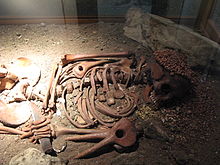Arene Candide
This article includes a list of general references, but it lacks sufficient corresponding inline citations. (August 2015) |

The Arene Candide cave is an important archaeological site in Finale Ligure, Liguria, Italy.
The name of the cave derives from a dune of white (candida) sand (arena) that was found at the base of the cliff in the Caprazoppa promontory, where the Arene Candide cave is, until the 1920s.
The cave is at 90 meters above sea level on the upper margin of the former Ghigliazza quarry, and presents three wide openings towards the sea. Thanks to its position and to those openings, the cave is well lit and relatively dry. Access is from above, via a 30-minute path from Borgio Verezzi.
History
The cave was locally known as Grotta dei Frati or Armassa, but it has been known under the current name since 1864, when Arturo Issel visited it, the first in a long series of archaeologists and geologists doing research here.[1][2][3][4][5]
The Arene Candide gained international celebrity after the excavation campaigns by Luigi Bernabò Brea and Luigi Cardini in the years 1940-42 and 1948–50, in the south-eastern part of the cave.[6][7][8][9] Their excavation brought to light a detailed stratigraphic sequence ranging from the Upper Palaeolithic to the Byzantine period,[10] thanks to the environmental conditions of the cave, that were key in the good conservation of finds, including organic material like bones and charcoal. The remains of 19 palaeolithic burials are among the most important funerary complexes in the world, thanks to their extraordinary preservation conditions, and enable a variety of anthropological studies with currently available scientific methods. Further excavations were carried out in the 1970s and 2000s.[11][12]
The most famous burial is of a juvenile male, around 15 years old, the so-called "Young prince" (Giovane principe), dated about 23,500 years BP in the Gravettian,[13] with an extremely rich set of grave goods. The body was deposed on a layer of red ocre, seven meters below the current surface of the cave, looking South, with a creel-like cap, jewels made of shellfish, animal bones, deer antler and a long flint tool in his hand. The Young prince bears the signs of a mortal wound below his chin, tidied up with yellow ocre before the final burial. Isotope analysis showed that approximately ¼ of the his diet consisted of marine protein[14]
Finds from the excavations are on display in several Italian museums, including the Museo di archeologia ligure in Genoa Pegli, the Museo archeologico del Finale in Finale Ligure and the Museo nazionale preistorico etnografico Luigi Pigorini in Rome.
References
- ^ Issel, Arturo (1864). "Di una caverna ossifera di Finale". Atti della Società Italiana di Scienze Naturali (in Italian) (7). Milano: 173–185.
- ^ Issel, Arturo (1886). "Scavi recenti nella caverna delle Arene Candide in Liguria". Bullettino di Paletnologia Italiana (in Italian). 7–8 (12). Parma: Tip. della Società fra gli operai tipografi: 112–133.
- ^ Morelli, Nicolò (1890). "Resti organici rinvenuti nella Caverna delle Arene Candide". Atti della Società Ligustica di Scienze Naturali e Geografiche (in Italian) (4). Genoa: Società Ligustica di Scienze Naturali e Geografiche: 273–317.
- ^ Issel, Arturo (1892). Liguria geologica e preistorica (in Italian). con note e disegni originali di N. Morelli; panorami e fotografie di G. Dallepiane. Genoa: A. Donath.
- ^ Issel, Arturo (1908). Liguria preistorica. Genoa: Società ligure di storia patria.
- ^ Bernabò Brea, Luigi (1946). Gli scavi nella caverna delle Arene Candide (Finale Ligure). Parte I Gli strati con ceramiche (PDF) (in Italian). Bordighera: Istituto internazionale di studi liguri.
- ^ Bernabò Brea, Luigi (1956). Gli scavi nella caverna delle Arene Candide (Finale Ligure). Parte I Gli strati con ceramiche. Vol. II Campagna di scavo 1948-50 (PDF) (in Italian). Bordighera: Istituto internazionale di studi liguri.
- ^ Bietti, Amilcare (1994). The upper pleistocene deposit of the Arene Candide cave (Savona, Italy): new studies on the 1940-42 excavations. Rome: Istituto italiano di paleontologia umana.
- ^ Maggi, Roberto; Starnini, Elisabetta; Voytek, Barbara (1997). Arene Candide : a functional and environmental assessment of the Holocene sequence : excavations Bernabò Brea, Cardini 1940-50. Rome: Il calamo. ISBN 88-86148-29-1.
- ^ Pastorino, Anna Maria (1997). "Roman and Late Roman layers in the cave of Arene Candide". Arene Candide: a functional and environmental assessment of the holocene sequence (excavations Bernabò Brea-Cardini 1940-1950). Roma. pp. 623–634. ISBN 9788886148290.
{{cite book}}: Unknown parameter|editors=ignored (|editor=suggested) (help)CS1 maint: location missing publisher (link) - ^ Tiné, Santo (1999). Il Neolitico nella Caverna delle Arene Candide (scavi 1972-1977) (in Italian). Bordighera: Istituto internazionale studi liguri. ISBN 88-86796-09-9.
- ^ Binder, Didier; Maggi, Roberto (2001). "Le Néolithique ancien de l'arc liguro-provençal" (PDF). Bulletin de la Société préhistorique française (98.3). Société préhistorique française: 411–422. doi:10.3406/bspf.2001.12528. ISSN 0249-7638. Retrieved 12 May 2014.
- ^ Hirst, Kris. "Arene Candide - Upper Paleolithic Burial of Arene Candide". about.com. Retrieved 23 August 2015.
- ^ Pettitt, P.B.; Richards, M.; Maggi, R.; Formicola, V. (2003). "The Gravettian burial known as the Prince ("Il Principe"): new evidence for his age and diet" (PDF). Antiquity (295). doi:10.1017/S0003598X00061305. Retrieved 25 August 2015.
{{cite journal}}: Unknown parameter|displayauthors=ignored (|display-authors=suggested) (help)
